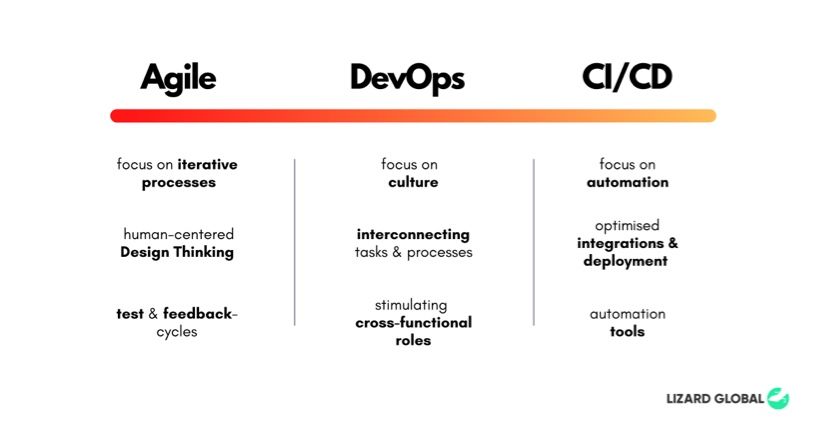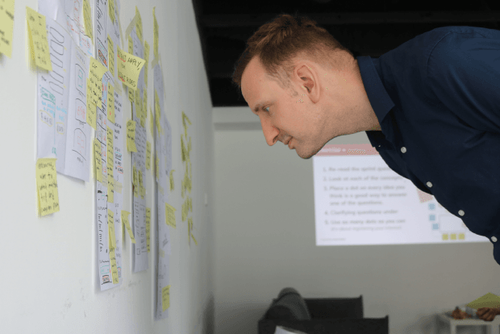An Introduction to GitLab
Get the latest updates about our blog posts.
Subscribe so you don’t miss out!
As a software development company, we’re continuously adopting new technologies and strategies to keep our internal processes agile and optimized at all times. We do this, among other things, by implementing CI/CD strategies. CI/CD, or Continuous Integration and Continuous Deployment, is a combination of automated build-test-feedback sequences (CI) and automated deployments (CD). At Lizard Global, we make use of GitLab as our Version Control System (VCS) to incorporate our CI/CD pipeline. But what is a VCS exactly? And why do we use GitLab? You can read more about it in this introduction to GitLab.
Agile, DevOps and CI/CD
The terms ‘Agile’, ‘DevOps’ and ‘CI/CD’ are often used interchangeably when referring to the optimization of business processes. And although these three terms are closely related to one another, they do differ in their focus and approach. The term Agile is defined by the ability to develop a user-centered solution in iterative sprints. These sprints allow end-users to iteratively test the product and provide feedback for improvements. Agile focuses on efficient processes that provide the opportunity to continuously improve the product and thereby heighten the chances of delivering a successful product that has significant value to the end user.
DevOps is a term combined from the words “development” and “operations”, and focuses on the combination of practices and tools used to increase a company’s ability to accelerate processes of product development and delivery. In other words, DevOps focuses on the merging of teams and operations and creates a cross-functional culture within an organization.
CI/CD is more technical than theoretical in nature. It forms the combination of Continuous Integration and Continuous Deployment, with a focus on the automation of these specific processes. CI focuses on the automation of certain tools for building and testing applications, while CD makes sure that teams can configure, package and deploy their product in a cost-efficient and automated manner at all times.

What is GitLab?
Now we’ve clarified the definitions of agile, DevOps and CI/CD, it’s time to dive into the tools that make these approaches to process optimization possible. GitLab is a cloud-based software and Git repository, providing free open and private tools for developers. Git is a so-called version control system (VCS), which is a tool for software developers to help them manage iterative changes to source code over time. So, Git’s main purpose is to manage changes made to the source code in one or multiple projects, while tracking its progress over time. Git allows one or more developers to coordinate their tasks and monitor their project files in one centralized space.
GitLab can be defined as a DevOps platform that enables developers to optimize their development processes with tools like project planning, source code management and local file exchanges, and all processes included in the software development lifecycle (SDLC). A SDLC includes making changes to the existing source code, and creating new source code when necessary.
Often, more than one developer is working and implementing adaptations in the same piece of code. Combining these adaptations would normally cause issues within the code and therefore the software. Repository managers like GitLab are designed to help resolve this by protecting the source code from conflicting code, and provide an easy way for developers to track adaptations in the code files and merge their changes in with other developer’s changes. GitLab is designed specifically for reducing product lifecycles and optimizing the overall productivity, which eventually increases value for the customer.
Why GitLab?
As most other software development tools, there are many options to pick from. GitLab is considered a complete end-to-end solution for developers, as all the tools they need are neatly packed into one single piece of software. This eliminates the need to manage and maintain multiple development tools at the same time, resulting in a more streamlined development process. Other examples GitLab benefits include:
- Continuously adds new features, following the latest technological advancements
- Offers the ability to do merge requests and code reviews
- Provides package management
- Supports a CI/CD lifecycle
- Provides and easy maintenance of code developed by multiple developers
- Can handle large amounts of data, ideal for bigger software development companies handling multiple large projects at the same time
- Guarantees protection against unauthorised access, usage, and distribution
Need a hand?
At Lizard Global, we work agile, while implementing all necessary tools and technologies to optimize our development processes and deliver the best possible solution to our customers. Do you want to know more about how we optimize our development processes at Lizard Global, and what tools and technologies our developers use to optimize their productivity? Get in touch, and our specialists gladly tell you more about the development of digital solutions at Lizard Global.
We need you!
Are you as passionate about digital innovation and technology as our developers, and do you have a knack for clean code and software development with a MERN tech stack? You might be the talent our development team is looking for! Give us a call or contact us on our social media channels, and perhaps you’re part of the Lizard Family soon.




